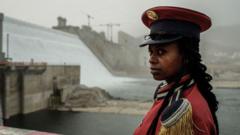Ethiopia has declared the completion of its massive Grand Ethiopian Renaissance Dam (GERD) on the Blue Nile, a hydro-electric project that has been a focal point of tension with Egypt and Sudan for years. Launched in 2011 with an investment of $4 billion (£2.9 billion), the dam stands as a symbol of national pride for Ethiopians, providing a critical source of energy that the country is in dire need of, especially since around 60% of the Ethiopian population lacks electricity access.
Prime Minister Abiy Ahmed emphasized that the dam should be viewed as an opportunity for cooperation rather than conflict. "To our neighbours downstream - Egypt and Sudan - our message is clear: the Renaissance Dam is not a threat, but a shared opportunity," he stated, indicating an invitation for both countries to attend the official inauguration slated for September.
The dam, which towers 145 meters high and stretches over a mile in length, is located in the Ethiopian highlands, where it captures 85% of the Nile’s waters. Egypt, which relies on the Nile for nearly all its freshwater needs, fears that the dam could diminish its water supply, with estimates that even a 2% reduction could dramatically impact its agricultural lands. Sudan shares similar apprehensions regarding the dam’s potential effects on its own water resources.
The recent discussions between Egypt's President Abdel Fattah al-Sisi and Sudan’s military chief, Abdel Fattah al-Burhan, highlighted their collective concerns regarding unilateral actions in the Blue Nile Basin. Although Ethiopia’s Prime Minister expressed a willingness to engage in constructive dialogue, previous negotiations have not yielded a resolution to the ongoing disputes.
Prime Minister Abiy Ahmed emphasized that the dam should be viewed as an opportunity for cooperation rather than conflict. "To our neighbours downstream - Egypt and Sudan - our message is clear: the Renaissance Dam is not a threat, but a shared opportunity," he stated, indicating an invitation for both countries to attend the official inauguration slated for September.
The dam, which towers 145 meters high and stretches over a mile in length, is located in the Ethiopian highlands, where it captures 85% of the Nile’s waters. Egypt, which relies on the Nile for nearly all its freshwater needs, fears that the dam could diminish its water supply, with estimates that even a 2% reduction could dramatically impact its agricultural lands. Sudan shares similar apprehensions regarding the dam’s potential effects on its own water resources.
The recent discussions between Egypt's President Abdel Fattah al-Sisi and Sudan’s military chief, Abdel Fattah al-Burhan, highlighted their collective concerns regarding unilateral actions in the Blue Nile Basin. Although Ethiopia’s Prime Minister expressed a willingness to engage in constructive dialogue, previous negotiations have not yielded a resolution to the ongoing disputes.



















